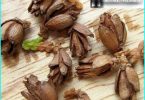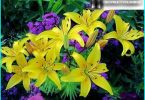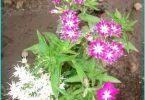The contents
Description shrubs of the genus Berberis
Plants of the genus Berberis represent a tree-like shrubs 2-3 m tall, widely distributed in the wild. Thanks to the beautiful appearance and useful fruits and leaves, it has become popular as a garden plant. According to one version, the name comes from the Arabic word «beiberi» due to the fact that the petals of Berberis vulgaris according to resemble a shell. The flowers are Golden yellow, collected in inflorescence or tassel. The smell of flowers is strong and pleasant. Beginning of flowering barberry in may – June. Crown spreading. Shoots arched away from the main trunk. In autumn the leaves acquire a purple color, so that the barberry is beautiful at any time of the year.
The fruit may differ in color. They represent an oblong berry about 2 cm in length, has a sour taste. Unripe fruits contain alkaloids in high concentrations, causing toxic. In the stems and roots contains an alkaloid berberine that has lemon yellow color and imparts the same color to the inner parts of the plant. The color, the tartness and acid of the fruit became the reasons for which the barberry is called «North lemon». Spines are modified leaves, shaped like tridents. Thanks to the powerful thorn barberry is widely used as hedges. Crown shape with trimming.
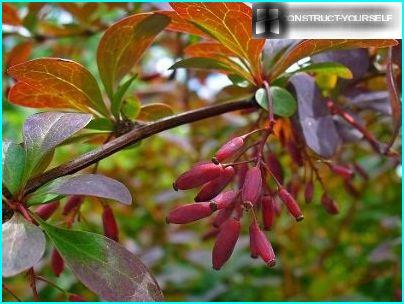
Spectacular variety Atropurpurea and planted in well-lit areas, in the shade the leaves lose their intense color
The home plants are the Crimea and the Caucasus, but it grows almost everywhere except in areas with extremely harsh climate. Best barberry develops in areas well lit by the sun. In the shadow also grows well, but have trouble with fruiting. The plant is drought-resistant, without consequences tolerate frost, but may die in waterlogged soil. Under excessive watering or frequent rains beginning to rot strong root system. The bushes are planted singly, in groups, in hedges. Low-growing varieties suitable for decorating the rocky hills. A genus of plants of the barberry has 175 species.
The diversity of species and varieties
There are over a hundred varieties barbarisov grown for decorating gardens and plots. There are several basic types, each of which often has more than one form:
- Berberis vulgaris;
- barberry Amur;
- arboris canadian;
- barberry Thunberg;
- barberry Ottawa;
- barberry Korean;
- barberry entire;
- barberry chiropody;
- barberry monetary.
Berberis vulgaris
Is a hardy shrub 1.5-2.5 m, which is able to settle down in areas with a fairly harsh climate – up to Western Siberia. Fruiting in the fourth year of life. The most popular three types:
- Atropurpurea. Hardy barberry with bright yellow flowers and edible purple fruits. The leaves of plants grown in well-lit areas, get a bright purple color. Seed propagation leaf color inherit not all of the descendants.
- Albovariegata. The shrub grows to a height of 1 m. the Leaves are dark green with stains.
- Aureomarginata. The peculiarity of this barberry variegated leaf color. Plant photophilous. In the shadow of loses the intensity of color of the leaves.
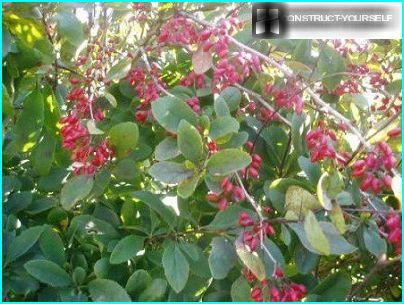
The color of the leaves of barberry unique, it may vary depending on the type of reproduction, and habitats of the shrub
Barberry Amur
Homeland plants are far East and Northern China. In addition to these areas, it grows in Primorye and Japan. It grows in the wild on river banks, forest edges. Resembles the Berberis vulgaris, but the bushes grow higher, up to 3.5 m. the Fruits are red, edible, have a sour taste. The leaves are large, toothed, shiny, green color. In the autumn turn yellow or become purple.
- Japonica. It is a kind of barberry Amur, featuring a beautiful leaf shape – rounded at the top. The number of flowers in inflorescences less than many other varieties – 6-12 (usually 20-25).
- Orpheus. This cultivar was bred by Russian breeders. Its peculiarity is the absence of flowering. Shrub height of about 1 m.
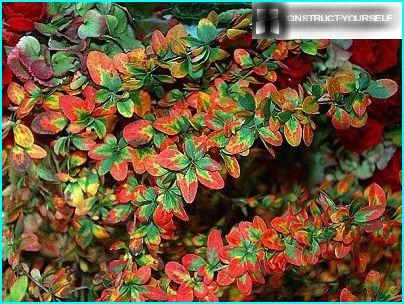
In autumn the shrubs of barberry Amur extremely picturesque
Barberry canadian
In nature the plant grows on rocks, shores and river valleys of North America. Flowering time – late may — early June. The shrub is undemanding, winter – drought resistant. Blooms and bears fruit very intensively. Resembles the Berberis vulgaris. In Russia almost is not popular, but in America for over two centuries gardeners pay much attention to the breeding of decorative forms of the shrub. Most often planted hybrids:
- Declinata;
- Oxyphylla;
- Rehderiana.
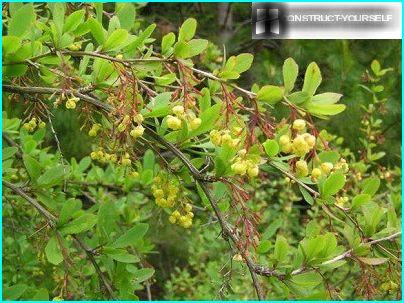
American breeders are working on breeding new varieties and hybrids of barberry canadian from 1730 g
Barberry Ottawa
It is a hybrid, obtained by crossing the Atropurpurea and Berberis vulgaris barberry Thunberg. Exceptional endurance, resistance to diseases. Flowers are the original color – bright yellow with reddish spots. The leaves can be red, orange, purple. Fruits with a yellowish tint. With good care, the tree grows to 2-3 m, gives good gains, recovers quickly after cutting. Most often, gardeners choose decorative varieties:
- Superba;
- Purpurea;
- Auricoma;
- Silver Miles.
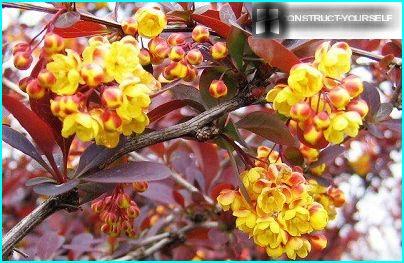
Yellow with red spots flowers and purple leaves produce a strong effect. Barberry Ottawa – perfect «material» for the landscape designer
Barberry Korean
A kind of shrub received its name from the Korean Peninsula, the homeland of the plant, where it can be seen on the slopes of mountain gorges. The plant is undemanding to soil, tolerates drought well, but can suffer from waterlogging during periods of long thaws. The Korean barberry can be nipped by the frost in cold weather, but, as a rule, are only the tops of the shoots. After cutting the shoots grow quickly. The plant is susceptible to rust. Flowers – yellow, fragrant. Fruit – round, red.
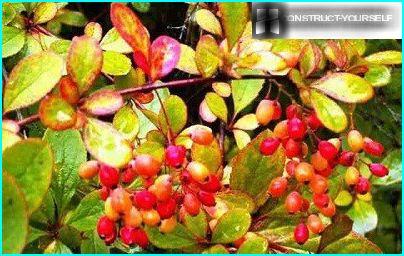
Red and yellow colors of Korean barberry is able to brighten even the most banal landscape
Barberry entire
Homeland barberry entire mountain regions of Asia. The Bush can reach 2.5 m. Flowers yellow, leaves green with a grey tinge, oblong. Interesting color of the fruit. They are red but have a darker shade and gray patina. Shrub unpretentious, can grow in any soil, except acidic. Young plants do not tolerate severe winters, they should be covered. The growth of demand for winter protection disappears. The shrub can be cut. Growing shoots with an average speed of.
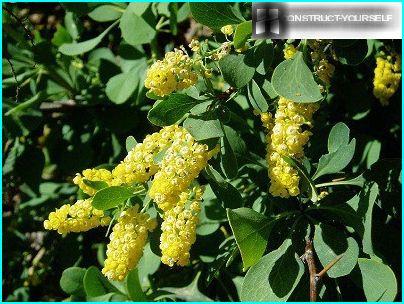
The number of flowers of barberry edged in brushes reach twenty!
Barberry chiropody
It is also called barberry ragnarokum. Distributed in mountain areas of Central Asia. The fruits are spherical, have a blue-gray color, widely used in cooking. Add them to the pilaf, shurpa, shashlik. A distinctive feature of the fruit of barberry sharapodinov – high content of vitamin C. in Addition to valuable fruit shrub differs spectacular appearance. The flowers are collected in small buds that have a strong scent. In winter, the plant may be nipped by the frost and is in need of shelter. While excess moisture can hurt. Shrub popular with gardeners Uzbekistan, Tajikistan, Kyrgyzstan.
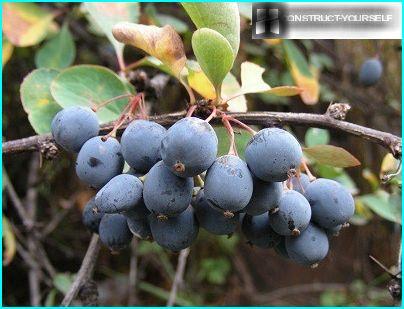
Ideal soil for growing barberry sharapodinov is considered gravelly, lime
Barberry monetary
The Motherland of Middle and Central Asia. The shrub grows on dry slopes. Bush height is usually about 2 m. the flower Colour is bright, Golden yellow. The fruits are red. Leaves small, oblong, green, may have a bluish tint. Shrub, inclined to be covered with ice in the cold, does not apply to zamostochie, but perfectly tolerant of heat. Below the root system of Berberis monecito not rot, it is necessary to monitor the amount of moisture, to provide drainage. Waterlogging can result in rust and plant death.
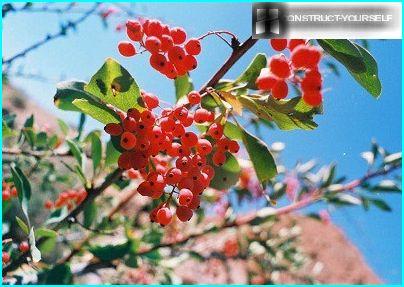
Barberry monetary great drought, but it is easy vypivaet in the rainy summer
Barberry Thunberg
The most popular among gardeners variety. Barberry Thunberg extremely diverse. Can be called no less than 50 common varieties, each of which has its own merit. Barberry Thunberg is widely used in landscaping. The shrub typically reaches 1 m in height and 1.5 m in diameter. Inflorescence composed of a small number of flowers – 2-4. Fruits bright red or coral-red. They look very nice, but they cannot be eaten.
Unlike other barbarisov, this variety is resistant to rust, powdery mildew. It grows well after cutting. Some varieties can be nipped by the frost in severe winters. As to describe the characteristics of each of the most popular varieties in one article is difficult, we offer you a list of the most beautiful barbarisov Thunberg:
- Aurea;
- Bonanza Gold;
- Carmen;
- Atropurpurea Nana;
- CrimsonPygmy;
- Kleiner Favorit;
- Minima;
- Little Favourite;
- Bagatelle;
- Kobold;
- Red Chief;
- Golden Ring;
- Coronita;
- Admiration;
- Dart’Lady’s Red;
- Dart’s Purple;
- Red King;
- Helmont Pillar;
- RedPillar;
- Red Rocket;
- Rose Glow;
- Kelleriis;
- Harlequin;
- Kornik;
- Pink Queen.
The following list is far from complete. It mentioned only the most beautiful and common varieties of barberry Thunberg. They are perfect to decorate the area. More detail see on the video:
How to choose grade?
Number of varieties of barberry is huge. You can pick them up so they decorated the area from may until the first frosts. The video below will demonstrate the diversity and beauty of the original barbarisov.
The use in landscape design
Barbarisi perfect for the decoration of rockeries, hedges and lawn edgings, rock gardens, Japanese gardens. The color palette is vast – from different shades of yellow and red to green, purple-blue. Luxurious composition obtained by combining barbarisov different varieties and when combined with other types of shrubs. Barbarisi use as the main background, and as contrast accent areas.
Dwarf varieties make out the edges of flower beds and lawns. Bush protects flowers and grass from trampling. Some gardeners use low-growing barbarity to design the foot of a large tree. It looks very picturesque. They are also used for decoration of Japanese gardens.
Barberries are often planted as a hedge. Thorns serves as a reliable protection of the site and looks nice. The fence can be left intact, and can be cut at your discretion. Well keep their shape barbarisi with erect branches. You can form a rounded crown. The video explains how to cut the barberry in the form of a fountain.
When and how to plant barberry?
The best time for planting of barberry – spring and autumn. The plant is propagated by seeds, cuttings, layering, division. The best option for the novice gardener is to buy a good seedling, because seed propagation is time-consuming.
To propagate the barberry cuttings, it can be cut off, planted in the fertile soil on the lawn or indoors, water and wait until roots appear. Ready seedling transferred into the open soil together with the soil from the pot.
During the multiplication of layering the escape pin, sprinkle the ground and the soil moistened until the nucleus will not take root. More convenient method – the division of a Bush. It’s removed from the earth, divide, separate. In this case, Bush quickly takes root and begins to bear fruit.
Barberry is not demanding to soils. As long as it is not flooded, and the place was well-lit. Planted shrub should be in the sun or in partial shade. For single bushes dig holes 0.5×0.5×0.5 m.
For hedges of any such pit or trench the desired length. Pit well moistened, equip drainage (suitable gravel, leaves, sawdust, etc.). After that, make the soil with fertilizers (superphosphate, peat, or humus). The landing site is ready.
The sequence of operations:
- In the prepared recess the seedling down so that the neck of the root was under ground at a depth of 3-4 cm.
- When hedge planting distance between individual shrubs should be 30-40 cm.
- Planting should be well watered.
- The last step is mulching the soil with sawdust or leaves.
As you can see — it’s pretty simple.
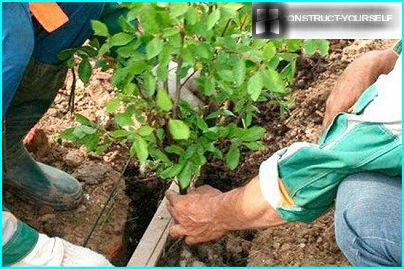
When planting barberry, be sure to smooth the roots of the seedling
Caring for shrubs: watering, fertilizing, pruning
Fertilize barberry begin in the second year after planting. For this purpose, urea (20-30 g per 1 bucket of water) or compound fertilizers (in doses indicated in the instructions). After this shrub are fed every 4-5 years.
Water the plant only in periods of long droughts. Just 2-3 times a week. Be sure to cut off the old and dry branches. If you want you can do the Bush cuts for crown formation. Such procedure is carried out 2-3 times per season.
Experienced growers recommend treating the shrub from pests. Most often it hit the aphids and the flower moth. The problem is solved using the solution fitofarm 0.2%. If the barberry was struck by powdery mildew, use a solution of fundazol (20 g per 1 bucket of water). Frequent attack – rust, deal with it 1% solution of Bordeaux fluid.


